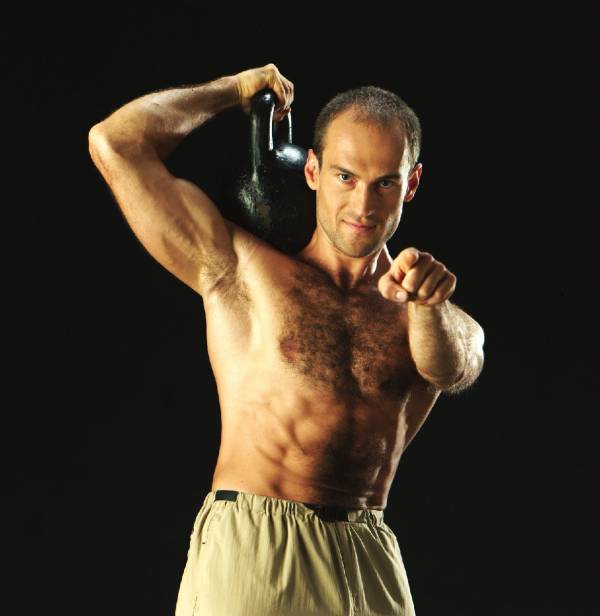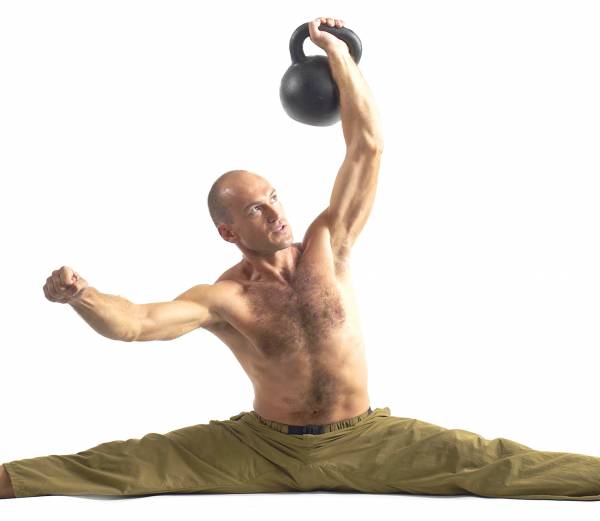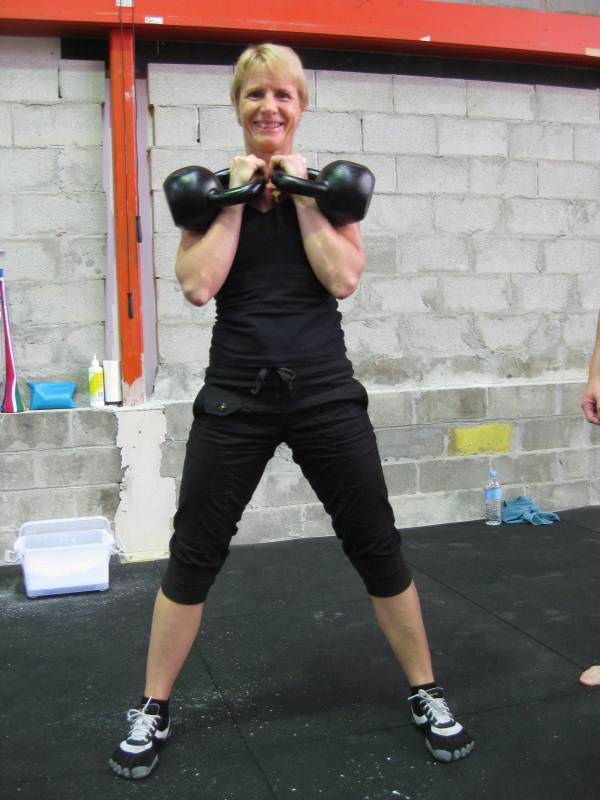It’s not often I stand in a roomful of trainers and feel like the dumbest one in the room. Yet that’s exactly how I felt on day one of my RKC in June 2009.
At the time in Australia there were only five or six RKCs and none were local. Yet all of a sudden not five or six, but eighty hopefuls and about twenty different instructors surrounded me. As each instructor introduced himself or herself I felt dumber and dumber, more and more like I was going to be hopelessly out of my depth.
Fast forward to now, and somehow at the start of the last RKC event I attended it was me standing at the front of the room introducing myself along with the other instructors, and now somehow even in charge of testing and running my own team. It’s pretty cool to be able to share this thing that has come to mean so much to me, both overseas and at home. Obviously, in all organizations things change as people move in and out of a position or new research comes along that shows a better way of doing something and the RKC is no different.
In its earliest guise the Russian Kettlebell Challenge was about one thing, from what I can gather speaking to those few foolhardy souls who braved the first few events: survive the epic Hardstyle beating of the Evil Russian, Pavel Tsatsouline. Senior RKC Shaun Cairns, one of the biggest strongest guys I have ever encountered, told me of a snatch workout at an RKCII event in 2008. With temperatures high and no chalk available, hands started tearing. Then bleeding. To try to keep a grip on the 24kg bell he was snatching, he started to rub his hands in the dirt at his feet. The more he bled the more dirt he used and the more he started to stick to the handle. As his hands stuck more, they tore more, and bled more, and then he got more dirt. This went on for twenty minutes.
Things have changed since then and that particular workout is no longer used for obvious reasons. As Master RKC Brett Jones said, “Over the 10-plus year history of the RKC there has been an ongoing progression and crystallization of the principles and techniques within the RKC system. Drawing from Pavel’s extensive background and knowledge and incorporating the work of many other fantastic coaches and systems (including contributions from within the RKC) the RKC is the ‘bleeding edge of the razor’ in Strength and Conditioning.”
Maybe it’s age. Maybe it’s because Pavel moved to California and some of his Eastern bloc toughness has been mellowed by surfer dude calm, but the RKC has certainly changed a lot since its early days.
But it’s always been the magic of Pavel and his ability to distil exercise instruction that has set the RKC apart. Like me, Master RKC Dave Whitley had the exact same feeling:
Since my first day at the RKC in June 2003 I have known I was a part of something special. A huge aspect of Pavel’s genius approach is taking the complicated and explaining it in simple terms. The importance of the “grease the groove” concept of developing the skill of strength cannot be over-emphasized. How many PRs have been set around the world over the years just because Pavel taught people to practice to success instead of work themselves to failure?
Another aspect is an emphasis on doing fewer things better. In 2003 there was no level two and there were 10 or 11 drills in the manual. As we went deeper into the skills, the RKC six became the level one material and some of the others (jerk, windmill, bent press) became the core of level two.
 These organic changes have been led by all within the RKC, not just by Pavel. I can think of one particular example of this evolution. In one of his first books, Power to the People, Pavel wrote about a moderate intensity, high frequency program that led to big strength gains. Power to the People turned the strength-training world upside down when it first came out. It was so revolutionary compared to the pump and blitz bodybuilding style that was in vogue.
These organic changes have been led by all within the RKC, not just by Pavel. I can think of one particular example of this evolution. In one of his first books, Power to the People, Pavel wrote about a moderate intensity, high frequency program that led to big strength gains. Power to the People turned the strength-training world upside down when it first came out. It was so revolutionary compared to the pump and blitz bodybuilding style that was in vogue.
Then, the program received a further update in Beyond Bodybuilding. The core exercises of a push and a pull for two sets of five repetitions became three to five exercises, performed three to five days per week, for three to five sets of three to five reps. Easy Strength anyone?
Dan John told me this about his early exposure to Pavel and how it changed his training philosophy:
My first exposure to Pavel and his methods was Jason Keen’s short summary of a twenty-five dollar workshop he attended. This is when the Internet was first really opening up and I think Keen’s article was one of the first non-bodybuilding or non-High Intensity Training articles I had ever read on the Net. Few may remember that “HIT Jedis” controlled and dominated the early Internet. Everyone was a Hard Gainer cursed by birth to a lifetime of weakness but blessed with an ability to type about it twenty-four hours a day.
Then, Pavel. Few know that I read Keen’s review and tested this Soviet’s training ideas. I did two sets of five of the overhead squat and the snatch grip deadlift five days a week and a hard flexibility stretch. Eight weeks later, I broke the state records in the snatch, clean and jerk, and total. To say that “I became a believer” is an understatement. I kissed the rattlesnake early on this movement.
Even in Dan John’s first foray into following Pavel’s ideas you can already see the idea of limiting the number of exercises, of going deeper into the skills, of frequent practice, and of this magic number of realistic reps that seems to do amazing things for us when it comes to strength development.
One of the things I think confuses people most about the RKC system is that they become attached to specific things. What I mean is, we refer to ourselves as a school of strength. So people hear that and begin to think what they need to do is lift more and more, and heavier and heavier. Or they hear the term “Hardstyle” and think it means “Uglystyle” and unnecessary, continuous tension.
But Pavel never said, “Comrades, don’t do anything other than lift.” One of his earliest books The Naked Warrior is perhaps the greatest example of the blend of “styles” of the RKC system. The essence of the book is the one-arm push up and single-leg squat. To perform both you need to be strong, symmetrical, mobile, and stable. You would be hard pressed to find a more balanced training regime.
 When Gray Cook first came along to the RKC he said Pavel had his attention when he said, “We are a school of strength AND movement.” This began a partnership with the Certified Kettlebell Functional Movement Specialist (CK FMS) course. This combination of strength as well as the movement is an important aspect of the RKC. It allowed us to, as Brett Jones explained, “’field strip’ exercises to get to the goal in the best way for the individual.”
When Gray Cook first came along to the RKC he said Pavel had his attention when he said, “We are a school of strength AND movement.” This began a partnership with the Certified Kettlebell Functional Movement Specialist (CK FMS) course. This combination of strength as well as the movement is an important aspect of the RKC. It allowed us to, as Brett Jones explained, “’field strip’ exercises to get to the goal in the best way for the individual.”
But as humans we like polarity, black and white, in our philosophies. How can one thing be both tension and relaxation? How can we lift heavy, but be flexible? At the end of last year Pavel offered some suggestions for New Year Resolutions, “A double body weight deadlift and do the splits,” he said. As always, he instantly distilled these two seemingly separate goals into a single unified approach.
It’s natural when you have a new toy that you want to play with it all the time. As RKCs we’re no different. When the CK FMS course first came along everyone went bananas for mobility. But we did this at the expense of one of the central themes of our school – strength.
This was most often seen in our assessment of the get up using the high bridge. Brett Jones reminded, “Remember the goal of the high bridge is to ‘clear the hips’ and once the hips are clear you should be practicing several varieties of the get-up – heavy, light, slow, singles, multiple reps, pressing during the stages, roll up (or tactical), ½ get-ups etc.” Yet somehow people started over emphasizing the high bridge and you would see people with backs so hyper extended that they looked like a rainbow. Meanwhile the testing instructors would have lasers and goniometers out measuring joint angles and the get up, and a lot of its benefits, just got lost in the process.
This decision to change one aspect of the get up is in line with our central goal as an instructor certification. Andrea DuCane, who has probably been to more RKC events than anyone other than Pavel said, “The quick, lasting, and life-changing results clients and kettlebell enthusiasts achieve with consistent kettlebell training. There is no other system that is as complete in total body strength, conditioning and mobility training.”
Brett Jones added, “Growing and adapting to the needs of the participants by addressing issues presented such as lack of a deep squat or lack of a hip hinge. This organic development has transitioned into an adaptive, but structured and reproducible system, making the RKC a sought after instructors certification.”
 One of these changes has just occurred – quite a big one. The RKC when I first attended was all about double kettlebells. Double the bells, double the fun. Yet recently we’ve switched to single bell. Many felt this would make things too easy. In their minds they see that half the load is half as hard. What they forget is that testing is only a small part of the RKC weekend and before they even get to the testing they need to put in two solid days of work beforehand. Not only that, but squatting, pressing and performing swings with an off centre load is a great sign of strength, mobility, and stability. It’s come full circle and is now more reminiscent of a loaded naked warrior than before.
One of these changes has just occurred – quite a big one. The RKC when I first attended was all about double kettlebells. Double the bells, double the fun. Yet recently we’ve switched to single bell. Many felt this would make things too easy. In their minds they see that half the load is half as hard. What they forget is that testing is only a small part of the RKC weekend and before they even get to the testing they need to put in two solid days of work beforehand. Not only that, but squatting, pressing and performing swings with an off centre load is a great sign of strength, mobility, and stability. It’s come full circle and is now more reminiscent of a loaded naked warrior than before.
For me, I’ve never trained clients with double kettlebells unless they decide to train for the RKC. There’s simply no need. They get the greatest core workout they possibly could simply from resisting the rotational forces of a single heavy bell and performing the RKC “deep six” of swing, get up, clean, press, squat, and snatch. In fact, I’ve seen people’s FMS screens improve greatly from doing no corrective work other than working on their RKC exercises with a single bell. And because we, the RKC, are like the strength world’s Jeet Kune Do, discarding the useless, and because we involve all aspects of movement and performance this single change is a great step.
Dan John summed it up better than I ever could:
So, to understand the RKC, I think you have to understand the impact of Pavel. So, be sure you see the underpinnings of pure strength, applied flexibility, and an appreciation of mobility work. Trust me, no one talked about mobility work in the United States and the magic (now more like the voodoo) of mobility before Pavel. When Pavel wrote “Vodka, Pickle Juice, and Kettlebells” for Milo Magazine, the stage was set: if you wanted to keep up, you had to learn kettlebells.
The RKC addresses the disconnect between how the human body works and the tools we have to teach, relearn, and discover how the human body works. One can deadlift amazing amounts of weights without ever understanding the hinge movement. A few correct kettlebell swings can illumine an athlete to perform at a higher level with less stress. The RKC system engages strength training, mobility, flexibility, correctives, cardio, and work production all in one tight package. We also keep ourselves open to the “What the Heck Effect” that illustrates this bizarre nonlinear insight that for whatever reason “doing this made this better.”
I see the RKC evolving, as we strive as a community to constantly lock down our rules, commandments, and directives, while concomitantly we are adding, challenging, and expanding our vision far beyond what we see today.
It’s a process that is not for the faint of heart. But, we can improve this “faint of heart” with swings.






